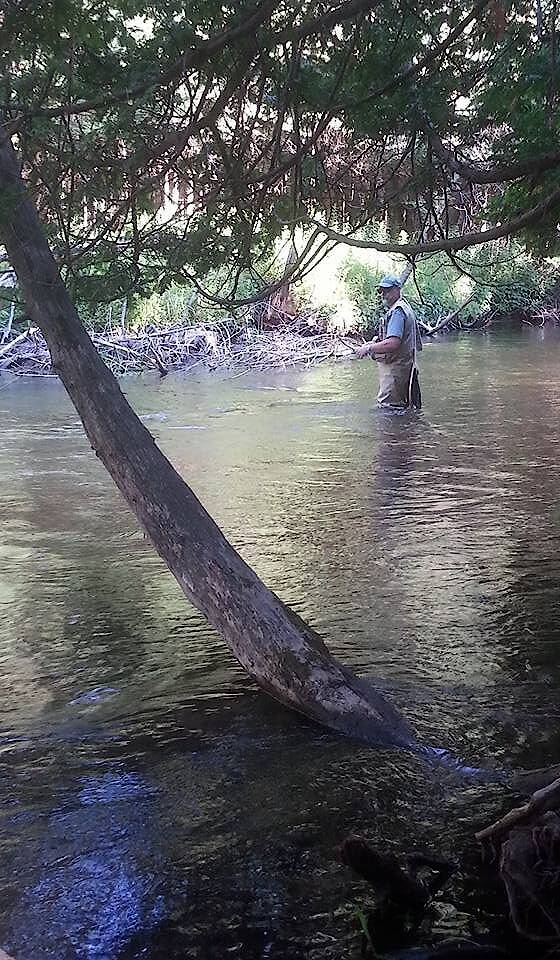
Hex Mayflies
Hexagenia limbata
The famous nocturnal Hex hatch of the Midwest (and a few other lucky locations) stirs to the surface mythically large brown trout that only touch streamers for the rest of the year.
Featured on the forum

Nymphs of this species were fairly common in late-winter kick net samples from the upper Yakima River. Although I could not find a key to species of Zapada nymphs, a revision of the Nemouridae family by Baumann (1975) includes the following helpful sentence: "2 cervical gills on each side of midline, 1 arising inside and 1 outside of lateral cervical sclerites, usually single and elongate, sometimes constricted but with 3 or 4 branches arising beyond gill base in Zapada cinctipes." This specimen clearly has the branches and is within the range of that species.

Troutnut is a project started in 2003 by salmonid ecologist Jason "Troutnut" Neuswanger to help anglers and
fly tyers unabashedly embrace the entomological side of the sport. Learn more about Troutnut or
support the project for an enhanced experience here.
Bmark0610 on Mar 12, 2015March 12th, 2015, 6:47 am EDT
Hey guys I am wondering which knot would be sufficient for my fly rod?
I heard that the simple nail knot will work just fine for every line to line attachment. Is this true?
I've done a double uniknot for attaching my braid to flouro when using kastmasters on my spinning rod. Would the nail knot work fine in this situation as well? I've had the uniknot break a few times on me when caught on a tree or whatever was under the water.
I'm by no means trying to catch monsters on either setup. 4lbs is probably the absolute largest fish.
Thanks
I heard that the simple nail knot will work just fine for every line to line attachment. Is this true?
I've done a double uniknot for attaching my braid to flouro when using kastmasters on my spinning rod. Would the nail knot work fine in this situation as well? I've had the uniknot break a few times on me when caught on a tree or whatever was under the water.
I'm by no means trying to catch monsters on either setup. 4lbs is probably the absolute largest fish.
Thanks
Wbranch on Mar 12, 2015March 12th, 2015, 7:26 am EDT
Firstly many guys aren't going to call the nail knot "simple". It can be a hard knot to tie so it finishes correctly and it is not a knot I would ever want to consider to tie while on a trout stream. Typically the sole purpose of the nail knot it to join the butt end of your leader to the end of your fly line. Today many modern fly lines already have a small loop on the end and most leaders have loops too. So all you need to do to join them is to complete what we call a "loop to loop" connection. It is kind of difficult to explain it on paper (I'm also lazy to try to explain it) but if you Google that term you will probably get a pictorial view so it is easy to understand. Some guys though still prefer the nail knot on the end of their fly lines.
You can also use the nail knot to join the back end of your fly line to your backing line.
If you are going to be making your own knotted tapered leaders or adding tippets to an existing leader there are two knots most fly fishers like to use; the blood, or barrel, knot and the double, or triple, surgeons knot. I use both and prefer the blood, or barrel, knot when I have plenty of time to make a nice leader but if I'm just adding a tippet I often use the double surgeons knot. I have no idea if the triple surgeons knot is any stronger. The double surgeons knot is constructed by laying the two leader sections parallel, keep the tag end from the main line extending over the tippet section at least 6", then holding both lines form a loop, then take the long end of the tippet and the short tag end of the main line through the loop once, and then again, and then moisten the loop with a little saliva and holding all the ends of the lines draw them slowly tight. Then clip off the tag ends.
You can also use the nail knot to join the back end of your fly line to your backing line.
If you are going to be making your own knotted tapered leaders or adding tippets to an existing leader there are two knots most fly fishers like to use; the blood, or barrel, knot and the double, or triple, surgeons knot. I use both and prefer the blood, or barrel, knot when I have plenty of time to make a nice leader but if I'm just adding a tippet I often use the double surgeons knot. I have no idea if the triple surgeons knot is any stronger. The double surgeons knot is constructed by laying the two leader sections parallel, keep the tag end from the main line extending over the tippet section at least 6", then holding both lines form a loop, then take the long end of the tippet and the short tag end of the main line through the loop once, and then again, and then moisten the loop with a little saliva and holding all the ends of the lines draw them slowly tight. Then clip off the tag ends.
Catskill fly fisher for fifty-five years.
RleeP on Mar 12, 2015March 12th, 2015, 8:25 am EDT
My experience has been that the triple surgeons knot is somewhat stronger than the double. However, above a certain diameter, a triple surgeons can be pretty bulky and isn't really worth the extra effort. As a general rule, 3X or .008 is where I set the dividing line between the two knots. That is to say, I use a double to tie 3X to 2X and a triple to tie 4X to 3X. And so forth in both directions along the leader.
I don't tie blood knots for the same reason that I don't use back flips to travel from the bedroom to the kitchen when I go to get my morning coffee. I've never found it necessary and there are easier ways to get it done.
But that's just me. You may learn the blood knot and come to love it...
Regarding other knots.. I like the uni knot for tying a fly to a tippet and also for attaching a leader to a fly line (aka the "speed nail knot"). You can even join two tippet sections with two uni-knots if you so desired ( I don't know anybody that does this, but it certainly makes a strong connection). Here's the uni-knot: http://www.animatedknots.com/uniknot/
I don't tie blood knots for the same reason that I don't use back flips to travel from the bedroom to the kitchen when I go to get my morning coffee. I've never found it necessary and there are easier ways to get it done.
But that's just me. You may learn the blood knot and come to love it...
Regarding other knots.. I like the uni knot for tying a fly to a tippet and also for attaching a leader to a fly line (aka the "speed nail knot"). You can even join two tippet sections with two uni-knots if you so desired ( I don't know anybody that does this, but it certainly makes a strong connection). Here's the uni-knot: http://www.animatedknots.com/uniknot/
Roguerat on Mar 12, 2015March 12th, 2015, 9:07 am EDT
Go to the Orvis animated knot page...neat videos and graphics, this will walk you through just about any knot a flyfisher will need.
That and burn through a spool or so of old monofilament practicing knots at home- beats trying to figure them out onstream!
BTW the Orvis tippet knot was rated right up there with the surgeon's knot variations- worth learning.
another 2-cents,
Roguerat
That and burn through a spool or so of old monofilament practicing knots at home- beats trying to figure them out onstream!
BTW the Orvis tippet knot was rated right up there with the surgeon's knot variations- worth learning.
another 2-cents,
Roguerat
Wbranch on Mar 12, 2015March 12th, 2015, 9:28 am EDT
$.03 worth - one of the easiest knots to attach a fly to the tippet is the Clinch knot. Put the end of the tippet through the eye of the fly, make the tag end about 3" long, twist the tag end around the main line 5 - 6 times, take the remaining tag end and insert it through the loop in the tippet at the eye. Slowly draw the knot tight. I have tied thousands of these knots and I think they are a snap to tie.
Catskill fly fisher for fifty-five years.
Flyflinger on Mar 12, 2015March 12th, 2015, 2:38 pm EDT
I've attached leaders to fly line by either a nail knot that I've further secured and smoothed over with AquaSeal or anchoring the leader within the fly line by piercing line with a needle, fishing out some of the core, and replacing it with an inch of leader butt coated thinly with Super Glue by drawing it from the end of the fly line into the cavity and out of the pierced hole. I then tie a small nail knot with the leader butt that came out of the pierced hole. I apply a thin coating of AquaSeal over the knot. I believe I got that from Dave Whitlock. Sure it takes more effort, but that attachment will never fail and is insurance for salt water fishing.
For tippet to fly, I've usually used either a tiny, non-slip mono knot or a Trilene or Rapala knot (forgot which one is the knot), which is simply two wraps over the hookeye before I tie what is essentially an Improved Clinch Knot. But I plan to use the Davy Knot this year because it is reputed to be a strong knot and is smaller than the Improved Clinch Knot. I intend to throw small wet flies and I figure I'll need a smaller profile of knot. I might ask for opinions about the Davy Knot on another post, since I don't wish for a thread-drift here.
For tippet to fly, I've usually used either a tiny, non-slip mono knot or a Trilene or Rapala knot (forgot which one is the knot), which is simply two wraps over the hookeye before I tie what is essentially an Improved Clinch Knot. But I plan to use the Davy Knot this year because it is reputed to be a strong knot and is smaller than the Improved Clinch Knot. I intend to throw small wet flies and I figure I'll need a smaller profile of knot. I might ask for opinions about the Davy Knot on another post, since I don't wish for a thread-drift here.
Martinlf on Mar 12, 2015March 12th, 2015, 5:40 pm EDT
Bob, you may want to use the double Davy for tippet to fly. I'll try to bump up the thread on this. Kurt did extensive testing, and I've found some studies that have similar results. It's my main knot now.
"He spread them a yard and a half. 'And every one that got away is this big.'"
--Fred Chappell
--Fred Chappell
Flyflinger on Mar 13, 2015March 13th, 2015, 1:42 am EDT
Thanks, Louis. I believe you are correct in that the Double Davy Knot is a vast improvement. I still end up with a smaller knot for the small wet flies I'm tying. Kurt's testing was quite convincing. It should be easy to tie in all conditions, esp. when my fingers become stiff from the cold. Now on to practice, practice, practice.
Wbranch on Mar 13, 2015March 13th, 2015, 4:58 am EDT
I guess I don't have the manual dexterity to effectively tie the Davy knot. I tried to tie it last night after reading these posts and I was totally unable to tie it. I have been using only 4 turns for my Clinch knot on flies #20 - #24 for years and have never had the knot slip out, or break at the knot, and I catch good numbers of 18"+ trout.
Basically it boils down to the old adage "You can teach an old dog new tricks".
Basically it boils down to the old adage "You can teach an old dog new tricks".
Catskill fly fisher for fifty-five years.
Jbehrendt on May 15, 2015May 15th, 2015, 8:51 am EDT
The nail works well for fly line to leader attachment, that or a loop to loop. I definitely prefer the double uni to anything else for constructing my leaders and leader to tippet connections, I have used the blood, double surgeons and a few others and the double uni may not be the easiest it is the most reliable and gives a thin profile. As far as attaching the fly to the tippet I use a double fisherman's (two times through the hook eye), at least that is what I have coined it, it is as strong as a palomar and easier to tie.
Fish when you can, work when you have to.
Quick Reply
Related Discussions
Topic
Replies
Last Reply
12
Aug 15, 2017
by PABrownie
by PABrownie
25
Aug 18, 2011
by Sayfu
by Sayfu






